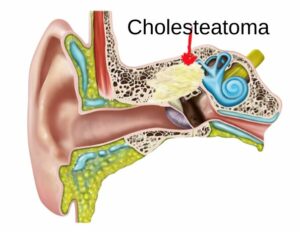Have you been diagnosed or maybe just suspect that you have hearing loss? There are four primary types of hearing loss. We’ll briefly describe each one in this article with recommendations.
1. Sensorineural Hearing Loss
Sensorineural hearing loss (SNHL) is the most common type of hearing loss and is caused by damage to the hair cells or spiral ganglion neurons in the inner ear (cochlea). Due to these damaged hair cells, the cochlea is not able to effectively convert its received energy into electrical signals to be forwarded on to the brain via the auditory nerve. Sensorineural is the most common type and accounts for about nine out of ten cases (90%) of all reported hearing losses. Most cases of SNHL occur with a gradual deterioration of hearing over years or decades. This type of loss can affect large portions of the hearing frequency range. It can also be accompanied by other symptoms, such as the ringing of the ears (tinnitus) and lightheadedness or dizziness (vertigo).
What Causes Sensorineural Hearing Loss (SNHL)?
The causes of this type of hearing loss are generally divided into two categories: acquired or congenital. Most people have acquired hearing loss. Acquired hearing losses are commonly age-related (presbycusis) or noise-induced hearing loss (NIHL).
Acquired means the hearing loss develops after a person is born and usually later in life. Causes may include:
- Aging: One of the most common health conditions of naturally growing older is presbycusis, or age-related hearing loss. Presbycusis affects one in three Americans between the ages of 65 to 74. This type of loss occurs over time, typically in both ears, and can be more difficult for a sufferer to notice.
- Noise: Noise-induced hearing loss (NIHL) can be caused by exposure to a one-time loud noise, such as an explosion or gunfire, or from extended exposure to sound louder than 85 decibels (dB).
- Infections and Disease: Viral infections including measles, meningitis and mumps can cause sensorineural hearing loss.
- Acoustic or Head trauma: Damage to the hair cells (stereocilia) in the inner ear also can be caused by a blow to the head or exposure to an extremely loud noise, such as an explosion. Many veterans suffer from sensorineural hearing loss due to exposure to firearms, artillery or jet engine noise.
- Tumors: Tumors can affect hearing and include cholesteatoma and acoustic neuroma.
- Medications: Many medications and chemicals are ototoxic. Medications known to cause hearing damage include certain antibiotics, anti-inflammatory medications and chemotherapy drugs.
Congenital sensorineural hearing loss occurs during pregnancy. Congenital hearing loss is rare compared to acquired hearing loss. Some causes are: premature child birth, maternal diabetes, lack of oxygen to the child during childbirth, genetics, and certain disease passed from the mother to the child in the womb.
There is no medical treatment or cure for SNHL. The most common management strategy includes the use of hearing aids. In cases where there is profound or total deafness, a cochlear implant may be recommended.
SNHL may be partially preventable by avoiding loud noises, ototoxic drugs, certain chemicals, head trauma, and the inoculation against triggering diseases such as meningitis.
Sudden Sensorineural Hearing Loss
Most of the time, acquired sensorineural hearing loss occurs gradually over time. In rare cases, the sudden onset of sensorineural hearing loss can occur, causing sudden deafness in one ear. The sudden loss of hearing is a medical emergency and immediate medical intervention is required.
How SNHL Affects How You Hear
Sensorineural hearing loss affects both the loudness and clarity of sound and speech.
Sensorineural hearing loss can affect all ranges or frequencies of one’s hearing. For those with age-related hearing loss, it is more typical to experience high-frequency hearing loss, or the reduced ability to hear high-pitched sounds.
Those suffering with sensorineural hearing loss report that they can hear but find it difficult to understand speech. This is particularly true in the presence of background noise.
2. Conductive Hearing Loss
Conductive hearing loss (CHL) occurs when sound is unable to effectively be transmitted anywhere through the outer ear (including the ear-canal), eardrum, or middle ear. Conductive loss symptoms may include the inability to hear soft sounds, a plugged up feeling, or ear pain. This type of hearing loss can often be treated medically or surgically. Referral to a physician, preferably a physician who specializes in diseases of the ear is recommended.
3. Combined or Mixed Hearing Loss
Combined or mixed hearing loss is a combination of sensorineural and conductive hearing losses. The conductive component should be treated medically, however, the sensorineural component can only be corrected through hearing aid or cochlear implant therapy. Hearing aid wear can be beneficial for persons with this type of hearing loss, but the underlying conductive component causal factors should be attended by a physician.
4. Auditory Neuropathy
Auditory neuropathy occurs between the inner ear (cochlea) and the brain. The transmission of signals from the inner ear to the brain is impaired. This type of hearing loss is known as auditory neuropathy, auditory dys-synchrony or auditory neuropathy spectrum disorder. Those with this type of loss generally have trouble understanding speech clearly. Hearing aid wear or cochlear implants have met with mixed success.
For more information on hearing loss or discount hearing aids, please visit HearSource.com.




